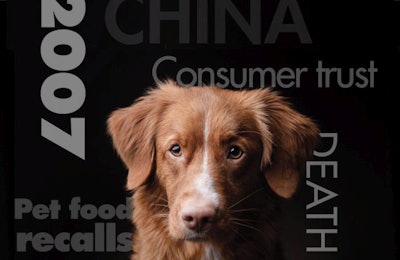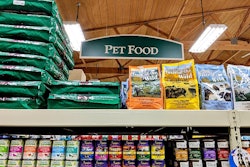
Over the past decades, several recurrent trends in pet food recalls have rattled the industry, including recalls related to melamine, Salmonella, jerky, pentobarbital and vitamin D. While large numbers of deaths were associated with some of these waves of recalls, many were precautionary measures especially following implementation of the Food Safety Modernization Act (FSMA).
Melamine pet food recalls
In March 2007, hundreds of dogs and cats began dying after mysterious crystals blocked their kidneys. The stricken pets had all eaten pet food adulterated with melamine and cyanuric acid by a China-based ingredient supplier. After eating that adulterated food, dogs’ and cats’ bodies became chemistry labs where melamine reacted with cyanuric acid to form durable crystals that clogged pets’ kidneys. By April 2007, those crystals had caused kidney failure in 236 cats and 112 dogs, according to a survey of veterinarians by the American Association of Veterinary Laboratory Diagnosticians and Michigan State University. The final number of deaths is unknown, but consumer reports to the US Food and Drug Administration (FDA) suggest that approximately 1,950 cats and 2,200 dogs died.
Along with increasing scrutiny of pet food suppliers and safety testing, consumer demands and legislative requirements were influenced by the melamine recalls.
In the decade since the melamine tragedy, pet food professionals from all levels of the industry have adapted to make pet food safer, more transparent and more regulated than before, Cathy Enright told Petfood Industry in 2017 when she was president and CEO of the Petfood Institute (PFI).
“The melamine adulteration was unprecedented at the time in food manufacturing,” Enright said.
Five key categories in pet food manufacturing have been refined since 2007 to avoid being blindsided again, she said:
- Identify reliable sources of ingredients
- Design hygienic, secure facilities
- Increase inspection and testing of ingredients
- Monitor manufacturing parameters such as temperature, pH, pathogens and equipment
- Ensure safety, quality and traceability of finished products
Salmonella-related raw pet food recalls
While the pet food industry has always grappled with Salmonella, recalls related to the bacteria became more frequent with the convergence of FSMA and the popularity of raw pet food. For example, from January 2017 to December 13, 2018, potential Salmonella contamination led to nearly 30 pet food and treat recalls. A sizable percentage of these have been raw pet foods.
To help pet food company’s navigate United States Food and Drug Administration guidelines (FDA) regulations, the agency provides Guidance for Industry documents.
Pentobarbital pet food recalls
Pentobarbital, a barbiturate, is used to euthanize animals and as a human sedative and anticonvulsant, as well as in human executions and physician-assisted suicides. Over the years, pentobarbital residues in pet food led to recalls and lawsuits, along with allegations that euthanized dogs and cats were being rendered into pet food.
In a 2004 report to Congress, National Renderers Association estimated that 165 rendering plants in the US and Canada pick up materials like fat and bone trimmings, blood, feathers and dead animals from animal shelters, slaughterhouses and ranches. While an analysis of dog and cat foods in 1998 found traces of pentobarbital, a 2000 study found no genetic evidence of canine or feline DNA in pet foods, which suggests that pentobarbital in the pet food supply chain came from euthanized livestock.
“Dogs and cats from shelters or anywhere else are not rendered into animal food in the US,” Jessica Meisinger, PhD, director of education, science and communication for the NRA and Fats and Proteins Research Foundation, told Petfood Industry in 2018.
Using dogs and cats in pet food ingredients is not condoned or sanctioned, said David Dzanis, DVM, PhD, CEO of pet food consultancy Regulatory Discretion.
“However, I am not aware of any rule that expressly and specifically prohibits the inclusion of materials from euthanized animals in rendered product,” he said. “Still, the presence of pentobarbitol in a feed or feed ingredient would be considered adulteration.”
In the past two years, pentobarbital residues led to several recalls of various dog food brands.
On March 2, 2018, the United States Food and Drug Administration informed J.M. Smucker that the company’s February withdrawal of pet food products, including Kibbles ‘N Bits, Ol' Roy and Skippy, from the marketplace is now considered a recall. The FDA based this decision on a test paid for by Smucker that confirmed the presence of pentobarbital in the tallow ingredient used in the affected products.
In February 2017, Evanger’s Dog and Cat Food of Wheeling, Illinois, USA recalled specific lots of its Hunk of Beef product because of potential contamination with pentobarbital. The company then expanded that recall in March. Party Animal recalled dog food in April 2017 for the same reason.
Vitamin D pet food recalls
Recently, high levels of vitamin D led to numerous dog food recalls. On December 3, the United States Food and Drug Administration (FDA) issued a warning to consumers about numerous dog food recalls related to excessive levels of vitamin D. Sunshine Mills, a co-packer or contract manufacturer, seems to have produced all the recalled dog foods, although the pet foods were marketed under different names. The recalled products were sold nationwide.
“F.D.A. scientists have evaluated samples of some of these products, and state and private lab test results indicate that the food contained as much as approximately 70 times the intended amount of vitamin D…” wrote FDA officials in the announcement.
Pet jerky recalls
More than 1,140 dogs have died after eating jerky pet treats, out of 6,200 cases of jerky-related canine illness reported to the FDA from 2007 to December 31, 2015. FDA released those figures in an update on its continuing investigation into animal illnesses and deaths related to jerky-style treats.
Many affected animals showed symptoms of a rare kidney disease, Fanconi-like syndrome (FLS), which is normally genetic. Most cases involved products imported from China, but some resulted from treats labeled as US-made.
However, the exact cause for these cases of FLS has not been identified. FDA continues to investigate the cause of these illnesses along with the Veterinary Laboratory Investigation and Response Network, an FDA-affiliated group of animal health laboratories. Lab analysis looks for pathogenic bacteria, toxic metals, radioactivity, pesticides and many other potentially harmful materials.














